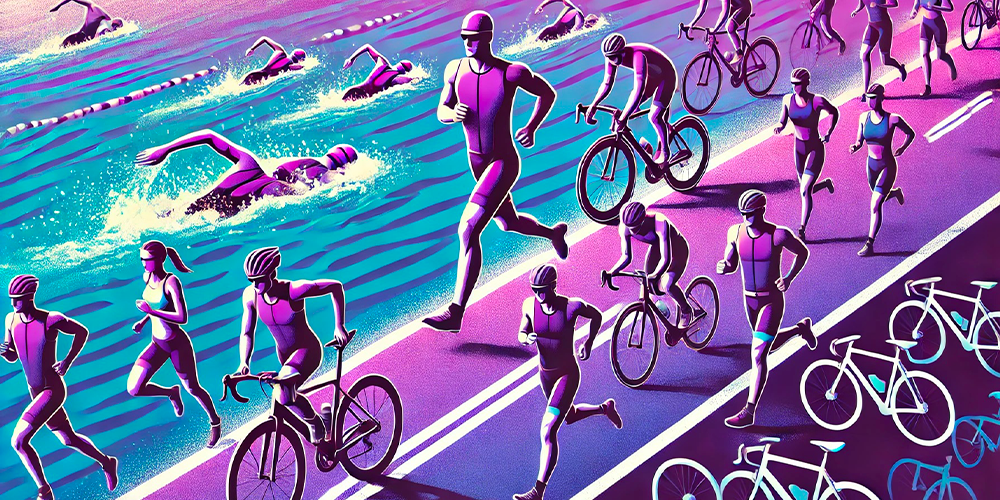Triathlon is a sport that encompasses three disciplines: swimming, cycling, and running. If we consider nutrition, we can rightly see it as the fourth discipline. The vast majority of races take place outdoors, adding uncertainty regarding the aquatic environment, roads, and trails to follow. Triathlon is also a discovery of one’s limits. Whether you are a beginner or experienced, there are mistakes to avoid to ensure your triathlon goes as smoothly as possible!
Article published in TrimaX-magazine n°231– September 2023 Author: Simon Billeau
This article was provided to us by Trimax Magazine, one of the leading triathlon magazines. A new edition is published every month, featuring articles, profiles, race tips, equipment advice, and much more. To discover all the latest news in triathlon, cycling, running, duathlon, and swimrun for free, click here.
1. Trying something new on race day
This could be a brand new pair of running shoes or a brand of gel you haven’t tested during training. Shoes quickly tried on in stores might turn out to be too small and cause blisters. The stiffness of new shoes also gets alleviated with training. After a few uses, they will mold to your feet. The same applies to gels. The acidity and/or glucose content in a different gel may not be well tolerated by your stomach.
The solution is simple: stick to using equipment you are familiar with and that your body accepts without issue. It’s advisable to test the nutrition brand that will be provided at the triathlon during training. For instance, it’s likely to be Maurten if it’s an IRONMAN event. The organization’s website usually provides this information. If the event you’re registered for is local, there may not be gels but slices of banana or orange. The key is to replicate in training the situation closest to the race.
2. Starting in the front line at the swim start
This is true if your swimming level is not “high.” It’s even more relevant if you’re not wearing a neoprene wetsuit while other competitors are. Wetsuits provide more buoyancy, giving those swimmers an advantage in performance and cold resistance. If you haven’t practiced in open water, you’ll discover the joys of the “washing machine”.
The short answer is to place yourself on the start line according to your level. However, how do you evaluate your level compared to others? It’s best to position yourself on one side. This avoids being in the “mix” and having a panic attack. On the outside, you can always move away from a competitor… Much less so when there are competitors on each side.
It is also recommended to practice in open water because, for one, the water isn’t as clear as in a pool. Additionally, it’s harder to navigate, highlighting the importance of knowing how to orient yourself. Practicing water polo swimming is the technique used to see where the buoys to be rounded are or the notable objects identified (a tree, a church…).
3. Starting too fast in each discipline
It’s “easy” to start too fast. On the one hand, the natural excitement of participating in a competition increases adrenaline levels. On the other hand, the race dynamics mean other competitors can draw you into paces that aren’t necessarily yours.
To avoid being swept up and burning out too early during the event, it’s wise to start cautiously and, if possible, gradually increase your pace as the race progresses. Managing your effort well will allow you to maintain a consistent pace.
4. Ignoring the rules in triathlon
Just as every citizen should not ignore the law, every triathlete must know the basic rules. If you follow a competitor too closely in non-drafting bike races, you risk being penalized, which can result in a penalty or disqualification if repeated multiple times. Other important rules include not littering outside designated areas.
It’s also the athlete’s responsibility to know the course. A volunteer’s incorrect direction or signage is not a sufficient excuse. Therefore, the first thing to do if you’re preparing to participate in a triathlon is to read all the information available on the organizer’s website.
After that, familiarize yourself with the courses by following the maps provided online. For this, it’s important to arrive well in advance. Sometimes, the site lends itself to an extended stay to enjoy with family. Moreover, the pre-race briefing, aside from being mandatory, generally offers the latest relevant information (wetsuit authorization or not, last-minute course changes).
5. Not planning your nutrition
Nutrition is likely the discipline where both novices and experienced athletes lack sufficient knowledge, whether regarding food products or their understanding of themselves in terms of digestibility and optimal nutritional intake.
Without complicating this vast subject, there are dishes or foods that should be avoided a few days before your race if your stomach is sensitive. This could mean avoiding eating fruits and vegetables because of the fibers they contain, or avoiding large quantities of proteins, alcohol, dairy products…
A simple pre-race meal is one that contains carbohydrates and a bit of protein, such as pasta with olive oil and chicken or turkey breast. If the race is early in the morning, it could simply be toast with butter and jam or honey, with coffee. Try to have your breakfast as far in advance as possible before the race, ideally 3 hours before. During the race, take advantage of aid stations for both nutrition and thermoregulation (sponges, sprays, ice…).
6. Not recognizing your bike’s location in the transition area
You’ve successfully exited the water, you’re running/walking to your spot in the bike area, but you don’t remember which row your bike is in…
Even though it’s prohibited to place a noticeable device on the rack, nothing stops you from having a bright pink or yellow towel on the ground or having stickers on the seat post that will catch your eye.
Additionally, the surrounding environment can sometimes help locate your bike. It could be a tree, an organization’s banner, or a relative shouting at you… But the best is to rely only on yourself.
7. Not wearing suitable clothing for triathlon
Blisters, chafing, burns… Triathlon is a sport with many risks of minor injuries if you don’t have the necessary equipment. In triathlon, the minimum is to invest in a tri-suit. This allows you to complete the entire event without having to change between disciplines.
Remember that nudity is prohibited in the transition area and that few organizations have a tent for this purpose. This tri-suit will also help you swim faster compared to just a swimsuit and will offer some protection against hypothermia. To protect yourself from repeated chafing, anti-chafing sticks can be applied to the armpits, neck…
8. Not practicing transitions
The specificity of triathlon is the succession of the three disciplines. Practicing the three disciplines independently could expose you to surprises if it’s your first triathlon.
T1: The first transition isn’t the most challenging, but it still involves major blood redistribution due to the rapid shift from a horizontal to a vertical position. Additionally, the primary active muscles are the arms in swimming, and during the transition, they stop propelling us forward in favor of the legs, accelerating these blood flows. This shift to a vertical position can also be a challenge in terms of balance, which is affected by the inner ear.
T2: The second transition is the most spectacular from a mechanical point of view. Leg incoordination following the cycling part isn’t just a myth. Numerous studies have shown the impact on the biomechanics of the locomotion pattern after the cycling section. If your schedule allows, bike-to-run transitions are effective in familiarizing yourself with this preload effect on your locomotor muscles. These transitions can be done in the form of short repetitions or a bike workout followed by a run session.
9. Not warming up
Warming up is crucial for endurance sports. The goal of warming up is to prepare yourself physically and mentally for the upcoming task. It increases body temperature, optimizes physical performance, and reduces the risk of injury.
The warm-up doesn’t need to be very long when it’s very hot, but it’s nonetheless essential. In triathlon, since your bike is already stored in the bike park, you can jog for 5 to 10 minutes before putting on the neoprene suit. If you don’t have a neoprene suit, and the water is relatively cold and the outside temperature isn’t very high, avoid warming up in the water and prefer a dry warm-up based on circumductions or, even better, swimming-like movements with bands if you have them.
10. Not having a bike in good condition
Presenting a bike in poor condition at the entrance to the transition area can be disqualifying. Additionally, the handlebar must be covered with end caps. And of course, the brakes must work.
The best way to be calm before a triathlon and avoid the risk of a DNF (did not finish) due to a mechanical cause is to have your bike serviced by a competent person. There are plenty of bike shops offering quality services. Some may think that the cost of a service is exaggerated. But what happens when you can’t finish the race that has incurred registration fees, travel expenses, and both financial and time investments?


